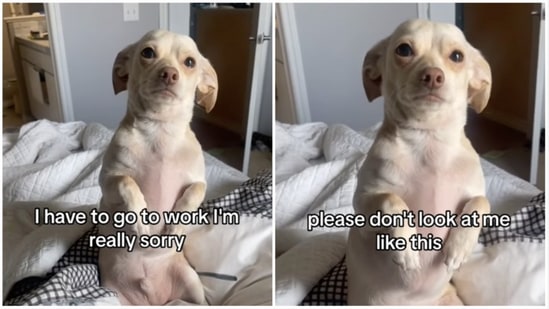Your boss won't let you bring your dog to work. Know how to help your fur baby's separation anxiety with these tips
Dogs with separation anxiety have a hard time coping with long hours away from their humans.
Your dog’s attached at your hip, wagging its tail and following you everywhere, whining for attention and belly rubs. Dogs are social creatures, and thousands of years ago, they were part of packs, so they consider you part of their pack and always want to be with you. And some days, it does feel like it’s you and your dog against the whole world.

But you have bills to pay, so work always calls. Trouble begins when your canine friend develops a severe dependency on you and experiences intense fear and anxiety whenever you leave for work, thinking they are abandoned. With a heavy heart and a guilt-ridden conscience, you leave for work, shutting the door on your dog, who whimpers and paws at the door for you.
Vets call this behaviour as separation anxiety, a condition where a dog experiences extreme stress and anxiety when left alone. Doctors say this is almost equivalent to a human panic attack, triggering all the stress hormones. This condition manifests as innocuous behaviors like whining, pacing, trembling, hiding your car keys, or even full-blown destructive behaviour like shredding and chewing your pillows and couch to bits and aggressive barking. The solitude becomes so overwhelming, that they try to escape and injure themselves. Loss of appetite, drooling, and urinating despite being house-trained are all glaring signs of separation anxiety. It has various causes like moving to a new house or city, the death or divorce of a family member, or past trauma with a history of abandonment and abuse.
ALSO READ: 5 ways to help your new dog settle into their home
Here are some tips to calm your dog so that you don’t feel like Cruella de Vil when you leave your dog for work:
Habituating being apart
When you know your dog is clingy, needy for attention and physical touch, and begins to panic when left alone, gradually train them to be alone every day. Leaving them abruptly might make them panic as they are not prepared. During this training, practice briefly leaving your dog in a room and returning before your dog starts to feel anxious. This reassures them that you will always come back after the 'alone time,' which helps to ease their abandonment anxiety, especially in dogs with past trauma. Increase the time spent apart gradually, starting with fifteen minutes, then thirty, and so on. This builds your dog’s confidence and independence. Always remember to treat your dog after you end the training session. This creates counter-conditioning, leading them to associate your departure with treats and may even make them look forward to it. If you have trained your dog with the ‘stay’ command, tell them to stay in the room until you give another command to call them.
Dissociate your departure cues
Dogs are smart; they pick up on your pre-departure behaviour, such as dressing up, putting on shoes, and packing a bag. These are visual cues that signal you will leave them for long hours. It triggers their anxiety, and they start shivering and whining. To calm the rising anxiety, don’t leave; instead, sit down, go about your household work, or watch TV. This trick helps break the association and gradually reduce their anxiety. By repeatedly performing the departure routine without actually leaving, your dog learns that cues like dressing up and picking up car keys won't always mean you are leaving, making them less likely to be disturbed when you actually leave for work.
Plenty of mental and physical exercise
Exercise is a good way to prevent crippling anxiety when you are about to leave. Dogs burn off their energy and feel content after a long walk in the morning. A tired dog is also less likely to be anxious when you leave. Puzzle games stimulate their minds and put their mental muscles to work, mentally tiring your dogs. By the time you leave for work, your canine friend probably settled for a nap from all that mental and physical workout.
ALSO READ: Is your dog in pain? From aggression to shivering, here are 6 hidden signs you shouldn’t ignore
Curb your dog’s clinginess (and yours too)
It’s normal to experience ‘cute-aggression’ with your furry friends, and you just want to smother them with your affection, cuddles, and kisses. It further fuels your dog's needy behaviour. But it’s important to foster independence for your dog's well-being. Downplay your departures and returns and keep them calm, avoiding over-the-top, high-pitched squeals about how much you’ll miss your dog. Keeping your goodbyes low-key will help your dog not dwell on your leaving. If your overly clingy dog's routine starts with head pats and ends with cuddling all day by your side, minimize this clinginess and encourage them to play with their toys. Bring new toys and puzzles to keep them excited. Love your dog, but give them space. Even love needs space to breathe and grow.
If nothing works, consider consulting a vet who can prescribe medication. However, continue working with your dog to build trust that you will always come back, no matter how long you are away.
ALSO READ: Recognising pet emergencies: 7 warning signs your furry friend needs immediate veterinary attention





